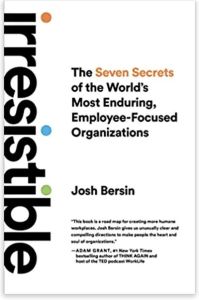Join getAbstract to access the summary!

Join getAbstract to access the summary!
Josh Bersin
Irresistible
The Seven Secrets of the World’s Most Enduring, Employee-Focused Organizations
Ideapress, 2022
What's inside?
Build a high-performance organization by treating employees well.
Recommendation
HR guru Josh Bersin applies his vast knowledge of motivation and learning to the challenging environment organizations face today. Based on extensive research into “irresistible” companies – those that maintain employee engagement over the long term – Bersin sets forth seven principles for attracting and retaining talent. His core theme: Field well-trained managers devoted to people’s growth and happiness, and reap the dividends as workers flourish. The book has won praise from luminaries such as Adam Grant, Arianna Huffington and Daniel Pink, and Bersin is developing an array of projects to highlight his findings.
Take-Aways
- Irresistible companies prioritize employee experience and reap the performance benefits in seven ways.
- Favor humans over hierarchy.
- Reward the work, not job titles.
- Make managers coaches, not bosses.
- Foster a worker-centric culture, and offer progressive approaches to compensation.
- Invest in continuous learning, and remove layers of management.
- Practice conscious capitalism.
- Empower and unleash your people to create mutual value.
Summary
Irresistible companies prioritize employee experience and reap the performance benefits in seven ways.
Josh Bersin chose “irresistible” to describe companies that maintain employee engagement over the long term – not just during their growth phase. These companies have organizational endurance, thanks to four factors: They pursue a compelling, timeless mission. They support employees’ productivity – and as a result, enjoy excellent growth and business outcomes. They make employee engagement a foundational value. And, finally, they support employees’ happiness by building trust, valuing fairness and creating social cohesion within the organization.
“Each individual, at every level of your company, is capable of doing more important and more valuable things than ever before.”
Bersin identified irresistible companies by analyzing more than 5,000 organizations in the Glassdoor database, which provides workers’ ratings of various aspects of employee experience at tens of thousands of companies. Although fewer than one-in-ten companies qualify as irresistible, these workplaces do exist in all industries and at organizations of all sizes and ages.
Irresistible workplaces attract talent, customers and other stakeholders, and they free people to contribute and innovate. Organizations enjoy increases in revenue and profits as a result. Companies become irresistible when their leaders understand the changes that have occurred in the world in recent years – including in technology and social awareness – and transform their organizations in response. Seven management practices embody these transformations and contribute to an irresistible workplace.
Favor humans over hierarchy.
Most organizations still follow the centuries-old system of top-down command-and-control management. This structure held sway through the Industrial Revolution. But it fails today, as most work has shifted from the routine and manual to the creative and cognitive. Today, a corporate structure of high-performing teams delivers adaptability and speed. Teams form, disassemble and re-form based on the tasks at hand and the precise skills and experience needed.
Small groups of people can rapidly build trust and relationships, much as winning sports teams do. People can move between teams easily, as their interests and the work demands. In some organizations, small teams called squads, comprising at most eight or 10 people, take on long-term missions and operate autonomously to achieve them. Squads participate in tribes of up to 150 people pursuing an overarching program or project. This kind of network, first developed at Spotify, facilitates cohesion and information sharing across the enterprise.
“People are most engaged when they feel a sense of ownership in their work, they are working in the right jobs, and they are clear on the team’s goals.”
Just as successful sports teams have capable coaches to lead them, so must work teams. Managers should view themselves not as bosses but as coaches who support, develop, empower, advise and inspire their team members. Solid, agile teams become greater than the sum of their parts.
They constantly learn, problem-solve, innovate and iterate while engaging in experimentation and healthy debate; they reach toward clear goals and hold themselves accountable for achieving them. In irresistible workplaces, team leaders embrace workers’ need for autonomy, development and meaning. They help team members see their progress every day and clearly connect it to the organization’s mission and purpose.
Managers provide feedback, resources and tools, and they encourage their people to grow, even when that means a person leaves the team for another opportunity elsewhere. Managers bring their teams together physically when possible, while supporting members’ preferences to work when and where they want.
Reward the work, not job titles.
The labor market has experienced a profound shift as workers, and especially youth, have flocked to gig-economy jobs and side hustles. Some two-thirds of younger workers already engage in paid work outside their full-time jobs, and even more appear poised to explore gig-economy work.
At the same time, the number of people quitting their jobs has reached an all-time high. Today, people are thinking in terms of work rather than jobs. Few expect to experience a traditional career path: remaining with the same company for decades, slowly moving up a hierarchy and then retiring.
“We have moved from an economy where your employer defines your career to one where your skills, experience and ambition drive success.”
Rather than career ladders, leaders should create lattices where people can move laterally and rotate through jobs for the sake of learning, experience and growth. In hiring, managers and recruiters should look for skills, passion and energy rather than a college pedigree, and they should find out what qualities truly contribute to performance in specific roles rather than assuming they already know.
Employees should be recognized and rewarded for moving around the organization – even leaving it and returning – thereby acquiring new knowledge, skills and relationships that can prove valuable for them and the company. As workers’ skills become more multifaceted and diverse, they bring unique combinations of abilities that differentiate them from one another and from AI systems and machines.
Some organizations have gone so far as to abolish job titles, and some have candidates apply to the organization rather than to a specific position. All of these steps encourage a mind-set in which workers flow to the places and problems that best leverage their abilities.
Make managers coaches, not bosses.
In irresistible workplaces, value derives from intangible ideas, innovation and collaboration – more than tangible fleets of vehicles, land, cash or buildings. In these workplaces, coaches, not bosses, understand the business, formulate plans and communicate a vision. They conduct regular one-on-ones with each team member; getting to know their people well enables coaches to advise, develop and inspire them.
This kind of manager gets things done by guiding willing team members, not by giving orders. At Southwest, for example, teams consist of pilots, crew and an airplane. Pilots routinely dive into the work of flight attendants, and flight attendants help the pilots, all working willingly and cohesively.
“Irresistible leaders excel at moving people into the roles that are right for both them and the organization.”
Traditional performance management systems pit employees in competition with one another. Irresistible companies instead apply the coaching model here, too. Frequent check-ins and feedback complement an annual formal review that pits employees only against themselves and their own goals and growth. Coaches work with employees to define goals based on objectives and key results, making them easy to track and adjust. These organizations pay people based on their value, not levels or titles.
Foster a worker-centric culture and offer progressive approaches to compensation.
At many organizations, the shift to remote work during the COVID-19 pandemic improved workers’ well-being, engagement and productivity; it underscored the advantages of a workplace favoring flexibility, freedom, fairness and transparency rather than rules and politics.
The workplace culture at irresistible companies emphasizes employee experience, inclusion, recognition and holistic well-being. The work environment is designed to accommodate and encourage teamwork, cross-functional collaboration, social connection, creativity, inclusivity and flexibility. It features up-to-date productivity tools and offers amenities that support workers’ health and convenience.
“The entire workspace should be focused on physical, cognitive and emotional well-being.”
Irresistible organizations provide training for managers in leading remote and hybrid workers, and ensure they understand the importance of diversity, inclusion, belonging, fairness and physical and mental well-being at work and at home. Coaches know how to listen and how to convey appreciation meaningfully. In a culture of respect and recognition that marks irresistible companies, coaches and leaders listen to their people, look for things employees are doing well, and praise and reward them.
Practices for determining pay are changing, too. At Google, a committee of managers decides on an employee’s pay, with the first-line manager having only one voice among many. Pay is evolving to depend on many factors that affect workers’ contributions, including their skills, reputation, leadership ability and growth potential – not only their current jobs. Leaders are beginning to see generous compensation as a potential area of competitive advantage, supporting a talented, committed and productive organization.
Transparency means employees will know the reasons for their pay and have access to the organization’s pay philosophy and the pay ranges of other employees. Irresistible organizations tend to pay above market rate and pay everyone, at minimum, a fair and living wage. They individualize pay, benefits and other rewards to suit individual preferences and needs.
Invest in continuous learning, and remove layers of management.
Leaders at irresistible companies make learning a priority, and support all workers to grow and advance. Leaders remove layers of management in favor of workers’ autonomy and continuous learning. Managers shift to evaluating team members not on face time and direct observation but on their value to the organization. As the organization’s needs change, train existing employees and promote from within where possible to save costs and drive engagement.
“The highest-performing companies always have one thing in common: They embrace a culture of learning.”
Continuous growth and learning matter more than ever because people are living longer and often pushing retirement out further. At the same time, in the face of automation, people’s current skills are becoming obsolete more quickly, while their needs to develop new ones are accelerating. The field of learning and development has been changing radically as well; it now emphasizes digital, self-directed and just-in-time learning, often augmented by predictive AI and machine learning that aid learners in real time.
Leaders at irresistible organizations create a culture that rewards learning hard and soft skills, and they encourage growth. They ensure people have access to learning tools and technologies and foster a growth mind-set, empowering employees to acquire new skills.
Practice conscious capitalism.
Like learning, many workers today place a high value on finding purpose and meaning in their work. Increasingly, employees, customers, investors and communities expect more from organizations, including a commitment to the environment, social progress and good governance. Employees want to know their work contributes to a greater societal and environmental purpose. When purpose drives an organization, profits follow.
“Purpose is the real fuel of a company. It gives people the energy, enthusiasm and creativity to add value in many ways.”
Capitalism has shifted from a singular focus on shareholder value and profits to one of accountability to multiple stakeholders. Irresistible organizations engage in so-called conscious capitalism, where good corporate citizenship practices engender stakeholder loyalty. Millennials and members of generation Z both rank environmental protection and climate change as their top concerns.
The COVID-19 pandemic appears to have inspired empathy, activism and a sense of community in young people. At irresistible companies, leaders ensure the organization has a mission statement and values that inform all decisions; each employee should feel connected to the mission, and that it serves all stakeholders equally well and with integrity.
Empower and unleash your people to create mutual value.
Irresistible companies apply design thinking to the organization of work and the employee experience. Leaders observe how people work, including their needs and what makes them thrive, and then design their work and employee-centric processes accordingly. They deploy workforce technologies that connect teams and workers and that benefit employees both at work and in their personal lives.
For example, at the software maker Autodesk, an innovative use of Slack ties all employees into a single communication platform, enabling cross-organizational collaboration and information sharing. And at the Mayo Clinic, a leader in health care, an interactive mobile app gives doctors immediate access to information and expertise on diseases and illnesses.
“If we win the hearts and minds of employees, we’re going to have better business success.” (General Motors CEO Mary Barra)
Provided leaders move ahead with transparency and respect for employees’ rights, preferences and privacy, organizations can use technologies and the data they generate to help employees connect and communicate, balance and integrate their personal and professional lives, and boost their overall well-being. Irresistible companies empower and unleash people to create mutual value.
About the Author
Josh Bersin is founder and CEO of the Josh Bersin Company, a global leader in research, advisory services and professional development for HR teams. During a five-year stint at Deloitte, he served as principal author and architect of the Deloitte Human Capital Trends study and created the “Simply Irresistible” model for employee engagement. Bersin sits on the board of UC Berkeley Executive Education.
This document is restricted to personal use only.






























Comment on this summary